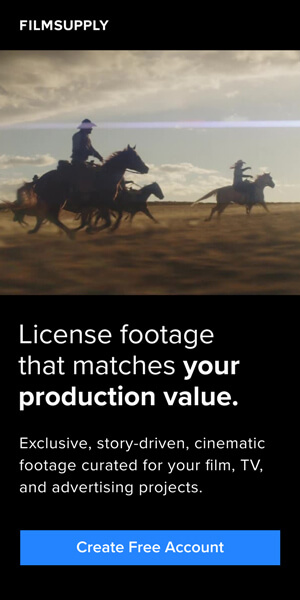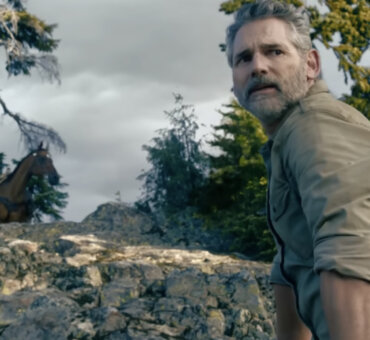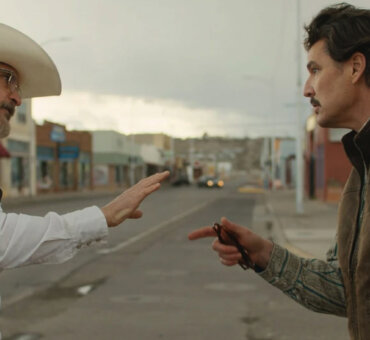They say, “A bad carpenter blames his tools.” But, if you’re looking on the bright side, the right tools can be made even more effective when put in capable hands.
We see it all the time at Filmsupply—creatives license our filmmakers’ work and turn it into something new and incredible. We live for it, but we don’t often get to take a peek into the process behind it, this metamorphosis.
Luckily, Michael Quinones and Ian Watt gave us this rare glimpse. As the senior content producer and director/senior creative, respectively, at Stink Studios, they recently wrapped three campaigns for Grammarly, built entirely from Filmsupply footage:
“It doesn’t take away the fact that we still need to shoot footage. In a lot of ways, we’re chomping at the bit to be able to go back and do what we do best,” Michael told us. “But, from a producing perspective, ‘it can’t be done’ is off the table now. There are so many different, unique opportunities for making things. I think the word “no” is an important word for a producer, but at the same time, I don’t have to use it as much anymore.”
What started as a creative solution to a production that existed fully within a pandemic, turned into a new way for creatives to think about building creative campaigns for clients. Beyond cinematic footage, they found a process that offered new opportunities.
We talked with Michael and Ian about their process and how they built Grammarly’s campaign out of stock footage—although, in our conversation, we all decided we hate the words “stock footage”.
Here are Michael Quinones and Ian Watt of Stink Studios.
Filmsupply: When did you start working with Grammarly on this project?
Michael Quinones: Actually, Grammarly came to us in the spring of 2020, which is kind of crazy. They reached out to us directly, right around the time when the pandemic was really raging in April. It was a very unique time in the marketing and advertising landscape as a whole. A lot of projects were going down and a lot of agencies were not pushing out material or spending money, and then Grammarly knocked on our door.
We’ve been working with them for almost a year and, from both a product perspective and an organizational perspective, they’re awesome. They’re fantastic people, and it’s a really dynamic product. For us, it was a great opportunity to sink our teeth into a technology product that was really intuitive. When you work with great people on both sides, it opens up a lot of creative opportunities.
Ian Watt: The biggest challenge of working in a pandemic, from the creative side, is building trust. Especially when we’re proposing an entirely stock campaign to a client, that’s a big ask.
How did you develop that trust, then?
Ian: Out the gate, we created this immense level of trust by approaching Grammarly with a really strong first-round presentation and saying, “We clearly understand your business needs.” Obviously, tech startups are driven by analytics, understanding the user data. We were able to ingest that and turn it into something more human-facing, and truthful. By doing that, it showed them that we’re a partner that can really understand their needs. We established that table stakes, and from there, it was easy to build off of that trust. From there, we were able to suggest doing an entirely stock campaign.
How confident were you with the concept of using licensed footage?
Michael: We’d been working with Filmsupply over the past few years, but honestly, Ian and I had sidebar conversations like, “How comfortable do we feel actually approaching an entire campaign with stock footage?” Pretty quickly Ian came back to me and said, “We can do this.” We weren’t conducting in-person shoots at the time, and this was a really viable solution that maintains the aesthetic and the quality standard as if we had shot it ourselves.
How did the creative process work once you got started?
Ian: We developed scripts, and then looked at the footage on Filmsupply. Some footage we found informed how we would tailor the script. Then, some moments in the script would change how we looked for footage. It was a really cool back and forth between looking at Filmsupply shoots and the script.
The way the footage is captured is conducive to this process, where it’s character-driven. If the main piece of content was relevant, we would dig into that filmmaker and find other collections of footage of that talent. Then, we would tailor the script to work through what we need to convey to the client.
It was like ping-pong. I’ve never worked in that way before, but it was a really fun puzzle to solve between all of those moving parts. And, can we just take a second and talk about James Ballard? This one filmmaker on Filmsupply has the largest collection of footage of the same two people [laughs]. We were writing up the script and were like, “What if the main character is on a cargo ship? Or, here he is in Indonesia, or here he is on the back of a boat.” We had these infinite options and it informed our creative process.
Michael: It’s a really interesting opportunity for storytelling. Essentially, you drop narratives into this material and you define who this character is—and they could be any type of person with any type of desire or goal. It’s a form of story-building, character-building that’s really interesting. It’s backward of how you originally think about it. Originally, you start with the script and you start with characters and then shoot the footage. This was the juxtaposition of that, which for creatives and producers and filmmakers, it’s super fun.
When Grammarly came to us originally, it was to participate in a pitch. We went from the pitch directly into the first campaign, which has led to three campaigns that we’ve produced with them, and we’re continuing to work with them in the future.
Did using pre-shot footage smooth out the feedback process from Grammarly?
Ian: It became iterative in a way that was really helpful. It was almost like making a documentary, where Filmsupply is this town that we’re visiting, and there are a ton of characters in this town that we can interview and use their stories to connect back to our material. We were always swapping out characters when we were presenting rounds of creative to the client. We would reveal the collection to them and say, “Here’s this one character that we’re calling Steven, and here are all the things that Steven’s doing, and all the different ways we could go with him.” They were really open to that process.
It’s the perfect product for this type of spot, too.
Michael: Exactly. Grammarly’s product lends itself to this process because it allowed us to see how the visuals would work with the actual product on the screen. We got to see the composition of the material that we would be placing the UI on top of, and how that might fit in relationship with this character in their situation. It might not work with every single brand or every single type of project, but with Grammarly, the product is the hero. We wanted to show how people are using Grammarly—whether it’s at home with their kids, in a boardroom meeting, or writing an email to their entire staff on the bus.
How do you make all of the footage feel cohesive?
It’s definitely a challenge because we needed to have this onscreen UI be the hero. Every piece of footage was living in this space behind the UI. People tend to look at the person on screen, and not necessarily the words being typed in some UI. We had to tailor these moments to make a smile or reaction happen at just the right time where we know someone will look at it and it’s not diverting away from the product.
There was a lot of chopping in a really fun way to make that happen. Some things are time-stretched and you’d never know it. Some backgrounds are extended and rebuilt to reframe for the UI. Again, it’s a tribute to the platform for having so much ultra high-res footage, because there’s so much reframing happening in each scene to make different moments from different shoot days of the same talent live within the same scene.
Michael: At Stink Studios, our bread and butter is the combination of storytelling and creativity, but also how motion plays a role in the narrative building. We wanted to have our lead motion designers work closely with Ian as he put together edits, so we could tap into Stink’s core strengths. Is each product-moment tying back to how we ultimately want people to understand the benefits of this product? All those things came together and it was just a good balance of what we do as a studio really well.
It’s a testament to Stink’s creativity for sure. People can use pre-shot footage as a crutch, but you used it as an opportunity.
Ian: That’s exactly the way we would put it, too. You have to think outside the box with some of these clips. Others are really straightforward and easy, and others you really have to get creative. The scenes don’t cut themselves.
What was the response from Grammarly?
Michael: There was a natural, delightful surprise to this project. And I think we felt something similar, too. We were excited to bring the concept to them and say, “There’s this really great, viable option.” Essentially, we took the idea of stock footage and rebranded it for them. We threw that term out the window.
Ian: There’s nothing like being able to say, “This is it. Here’s the round-one mood film. By the way, this is also round-one of production.” People get caught up in the word “stock,” and that word obviously carries a connotation. To me, Filmsupply isn’t stock. It’s prerecorded, narrative scenes. Some of them are more ambiguous, that you can plug in and interpret, and others are ultra-specific, but in a way that actually inspires the creative. It’s hard to define a term that actually could convey that to the client. The best part of it is, we can just grab the footage and show them.
Michael: And it’s made by true filmmakers, too. It’s as if we hired James Ballard to help us produce this spot. We have a very high expectation about the work that we put out across the board. The quality of the material really matters, so being able to have a bank of material to work from, by other creatives, other filmmakers, who have a similar type of approach to filmmaking is an incredible opportunity.
Will your experience on the Grammarly campaign change how you approach new work?
Ian: One hundred percent. One thousand percent. It’s dangerous, because as an editor—dare I say a proficient one—I can be also the lead creative and say, “We don’t need to shoot anything. It’s already been shot.” From an editor’s perspective, that’s a tool in the toolbox that is unprecedented because I can just source material and craft and create and iterate and change things and explore. You can’t do that anywhere else.
Each clip represents thousands of dollars of people’s time, effort, craft, equipment rental, booking, and most importantly, snacks [laughs]. I can reap the benefits of all of that with a download click, and that’s dangerous. I love it. Truthfully, we haven’t reached a point where we’ve needed to shoot anything yet. Normally we’ll get a brief and it’s like, “How do we make this broad, global?” With Filmsupply, honestly, I haven’t found the end yet.
Michael: It doesn’t take away the fact that we still need to shoot footage. In a lot of ways, we’re chomping at the bit to be able to go back and do what we do best. But, from a producing perspective, “it can’t be done” is off the table now. There are so many different, unique opportunities for making things. I think the word “no” is an important word for a producer, but at the same time, I don’t have to use it as much anymore.
Discover more ads that required little-to-no production by reading “5 Examples of Production-Free Ads That Work”.






